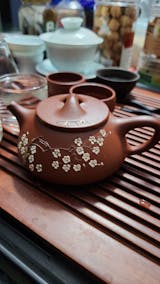
Zisha Clay Properties & Tea Pairing Guide
|
Clay Type |
Porosity |
Heat Dissipation |
Absorption |
Aroma Retention |
Best For |
Avoid |
|
Zhu ni (Vermilion Clay) |
Low |
Fast |
Medium-Low |
★★★★★ |
Fragrant oolongs (Phoenix Dancong, Tieguanyin), Black tea |
Ripe puerh (traps earthy notes) |
|
Zi ni (Purple Clay) |
Medium |
Medium |
Medium |
★★★ |
Ripe puerh, Dark tea, Roasted oolong |
Green tea (may overcook) |
|
Duan ni (Yellow Clay) |
High |
Fast |
High |
★★ |
Green tea, Young raw puerh, White tea |
Dark teas (stains easily) |
|
Jiang po ni (Slope Clay) |
Medium-High |
Medium |
Medium-High |
★★★★ |
Rock oolong (Rougui, Shuixian), Aged tea lumps |
Light teas (loses aroma) |
|
Di cao qing (Base Layer Clay) |
Medium-High |
Slow |
High |
★★★ |
Aged puerh (10+ years), Aged white tea |
Light oolongs (weak aroma) |
|
Lu ni (Green Clay) |
High |
Fast |
High |
★★ |
High-mountain oolong, Yellow tea |
Fermented teas (absorbs odors) |
|
Hei ni (Black Clay) |
Low |
Slow |
High |
★★★ |
Ripe puerh, Fu brick tea |
Fragrant teas (mutes aroma) |
|
Tian qing ni (Celestial Clay) |
Very High |
Medium |
Medium-High |
★★★★ |
Premium rock oolong, Ancient tree puerh |
Low-grade teas (waste of clay) |
Key Explanations
1. Porosity: Affects tea liquor thickness and aging potential (high porosity suits "breathing" teas like raw puerh)
2. Heat Dissipation: Determines steeping control (fast dissipation protects delicate teas like green tea)
3. Absorption: High-absorption clays need dedicated use (e.g., Duanni, Lüni)
4. Aroma Retention: Zhuni is best for fragrant teas; Duanni weakest (best for light teas)
Pro Tips
l Beginner Choices: Zi ni (versatile), Zhu ni (aromatic teas), Duanni (fresh teas)
l Aged Tea Specialists: Di cao qing, Jiangponi
l Never Mix: Duan ni/Lü ni easily absorb flavors - dedicate to one tea type
This table provides quick reference for optimal Zisha clay-tea pairings. Recommended for bookmarking!

